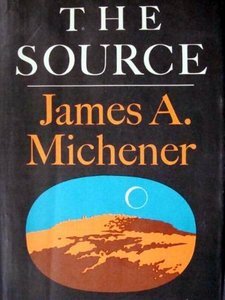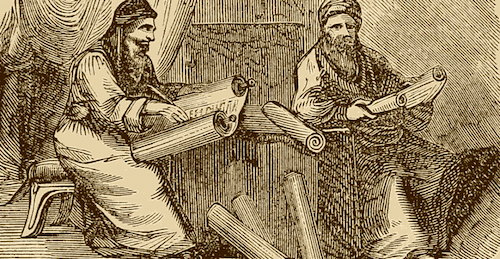Excavating James Michener’s The Source
My new novel will take place in 1970, and a central character is a young American Jew, and a member of the Zionist Youth Group Habonim. She’s smart and single-minded, and even if I don’t share her politics, I like her a lot and am curious to find out what will become of her as she heads to Israel for a year of volunteer work on an archaeological dig.
When I begin to research a novel that takes place in the past, I tend to use what I call the sandwich method. I begin generally, write most of a draft, and save specifics for a point when I better know the direction of my story. The key thing early on is this: getting inside my character’s head. What are the rhythm of her thoughts– this theoretical girl of mine? How would she see the world?
Of course, my character would have read The Source.
 My parents must have had a copy of that novel, along with Golda Meir’s My Life and Moshe Dayan’s Living with the Bible on their shelf just below their very scary portrait of David Ben Gurion. Indeed, for me, reading The Source in public felt a little embarrassing, like wearing a Young Judea tee shirt that doesn’t fit anymore. I considered carrying it around in a paper bag.
My parents must have had a copy of that novel, along with Golda Meir’s My Life and Moshe Dayan’s Living with the Bible on their shelf just below their very scary portrait of David Ben Gurion. Indeed, for me, reading The Source in public felt a little embarrassing, like wearing a Young Judea tee shirt that doesn’t fit anymore. I considered carrying it around in a paper bag.
Published in 1965, The Source is a door-stop of a novel, designed to take us through the history of the imaginary Tel Makor, an archaeological site in the Galilee.
A Tel is a mound formed by layers of ruined settlements. This one is excavated by an Irish American, and two Israelis (an academic, and a sexy female authority on ceramic shards), with assistance from a friendly Arab with a British accent. With present-day Israel as starting point, the novel travels the fifteen levels of the Tel from the bottom up, reaching back to the Stone Age– each with their piece of what I now know is called “Material Culture“, a primitive scythe, a fertility goddess, a glass vial for perfume, a golden menorah, and so-on– leading to Israel’s ’48 war and a battle to “liberate” Safad.
of what I now know is called “Material Culture“, a primitive scythe, a fertility goddess, a glass vial for perfume, a golden menorah, and so-on– leading to Israel’s ’48 war and a battle to “liberate” Safad.
Well, reader, it was a slog, but I finished it. After 1080 pages of this weirdly compelling information-dump, at some point, I realized that I wasn’t reading Zionist propaganda. I was reading a particular American writer’s perception of the history of a particular few square miles of the Galilee, which (post Jesus) he begins to call The Holy Land.
For me, reading a novel like The Source is an exercise in double-think. through the eyes of my novel’s protagonist, and also as a cultural artifact.
. On those terms, a few things surprised me.
James Michener’s Israel of the early sixties is a placid place. Early on, we see a lovely, white stone house with “graceful Arabic arches” which the archaeologists plan to use as a base. The Arab assistant informs the American that it was probably owned by an Arab olive-grower a few hundred years ago. Of course the olive-grower was more likely expelled or fled in 1948, but tensions arising from that war– both internal and external–play no part in the contemporary Israel of the novel. Instead, we read about conflicts between European Jews and Mizrahi immigrants, tactless kibbutzniks and vulgar Jewish-American capitalists, and perhaps most critically, between religious laws and secular principles which are perhaps most corrosive and complex, which leads me to… When it comes to religion, Jews can’t compromise, and that may not be a good thing. Yes, Jews are central to the novel which is, after all, based on an imaginary archaeological dig in Israel, but historically those Jews are exiled from the city of Makor time
“graceful Arabic arches” which the archaeologists plan to use as a base. The Arab assistant informs the American that it was probably owned by an Arab olive-grower a few hundred years ago. Of course the olive-grower was more likely expelled or fled in 1948, but tensions arising from that war– both internal and external–play no part in the contemporary Israel of the novel. Instead, we read about conflicts between European Jews and Mizrahi immigrants, tactless kibbutzniks and vulgar Jewish-American capitalists, and perhaps most critically, between religious laws and secular principles which are perhaps most corrosive and complex, which leads me to… When it comes to religion, Jews can’t compromise, and that may not be a good thing. Yes, Jews are central to the novel which is, after all, based on an imaginary archaeological dig in Israel, but historically those Jews are exiled from the city of Makor time  after time because those Jews refuse to bend. In fact– dare I say it– throughout the generations, Michener’s Jews are down-right stiff-necked. In some cases– say, during the Spanish Inquisition– those qualities are presented as admirable (and bring them back to The Holy Land). Yet more often, Jews are taken to task for caring more about Law more than Mercy (sound familiar?) It’s an old Christian Anti-Semitic trope. It’s an unresolved conflict in the novel, a paradox, because Jewish law often presented as petty and counterproductive, but as far as Michener is concerned, following law is what makes a Jew a Jew. And here’s the real surprise: Yes, Palestinians were always in Makor– and by extension, Israel. They were just called something else. I’m a
after time because those Jews refuse to bend. In fact– dare I say it– throughout the generations, Michener’s Jews are down-right stiff-necked. In some cases– say, during the Spanish Inquisition– those qualities are presented as admirable (and bring them back to The Holy Land). Yet more often, Jews are taken to task for caring more about Law more than Mercy (sound familiar?) It’s an old Christian Anti-Semitic trope. It’s an unresolved conflict in the novel, a paradox, because Jewish law often presented as petty and counterproductive, but as far as Michener is concerned, following law is what makes a Jew a Jew. And here’s the real surprise: Yes, Palestinians were always in Makor– and by extension, Israel. They were just called something else. I’m a little slow on the uptake, but at some point I realized that the Stone Age bee-keeper named Ur moved through the generations, became a Cannanite, became a Jews, became a Christian and became a Muslim, and that the Ur family outlasted empire after empire, and his right to the land is evident because each Ur from Makor will switch to the winning side to stay there. Jews don’t. I don’t want to give too much away, but you won’t be surprised to learn that as Michener presents the outcome of battle of Safed in 1948, the band of valiant Jewish soldiers discover that every single Arab had fled the city. One Jewish soldier actually goes after them in a stolen jeep, pleading with them to stay. And one Arab does–the descendant of Ur with roots all the way down the fifteen levels of the Tel to the Stone Age Makor cave.
little slow on the uptake, but at some point I realized that the Stone Age bee-keeper named Ur moved through the generations, became a Cannanite, became a Jews, became a Christian and became a Muslim, and that the Ur family outlasted empire after empire, and his right to the land is evident because each Ur from Makor will switch to the winning side to stay there. Jews don’t. I don’t want to give too much away, but you won’t be surprised to learn that as Michener presents the outcome of battle of Safed in 1948, the band of valiant Jewish soldiers discover that every single Arab had fled the city. One Jewish soldier actually goes after them in a stolen jeep, pleading with them to stay. And one Arab does–the descendant of Ur with roots all the way down the fifteen levels of the Tel to the Stone Age Makor cave. So what did I learn from reading The Source? To be fair, I got a good base-line understanding of biblical archaeology which came back in almost cut-and-pasted passages when I went on to read nonfiction on the subject, I also learned far more than I ever cared to learn about how a Christian looks at the Crusades . I came away wondering this: how did Americans think about Israel when The Source was published in 1965?
 Prior to the 1967 War, Israel and American had yet to form their current symbiotic relationship. Of course, there was Leon Uris’s Exodus, written in 1958 and of course, its film version from 1960. indeed a work work of Zionist propaganda and a wildly popular one, but that novel doesn’t address what happened once the state was established in 1948. What about Israel in 1950 or 1960? Did Americans look beyond the overheated tangle of Paul Newman and Sal Mineo, and imagine what this state became?
Prior to the 1967 War, Israel and American had yet to form their current symbiotic relationship. Of course, there was Leon Uris’s Exodus, written in 1958 and of course, its film version from 1960. indeed a work work of Zionist propaganda and a wildly popular one, but that novel doesn’t address what happened once the state was established in 1948. What about Israel in 1950 or 1960? Did Americans look beyond the overheated tangle of Paul Newman and Sal Mineo, and imagine what this state became?
Here’s a question: Was The Source actually a response to Exodus? How would Michener feel about the clam: “This land is mine! God gave this land to me.” (Lyrics by Pat Boone!). The excavation of Tel Makor makes it clear that the land doesn’t belong to Jews alone. James Michener was no Zionist. He was a lapsed Quaker, a liberal and a humanist. He liked to dig into history, and like all biblical archaeologists of the period, he imposed stories on his artifacts, what Nadia Abu al-Haj calls “facts on the ground”, However, it was a humanist story. Now, I’m imposing my own story on this artifact too.
So yes, my character would have read The Source. She would have loved the details, been attracted by its humanism, and perhaps would have seen hope in the consistent presence of that Ur family in Tel Makor. She would have wondered– as some other Zionists did– if the Arabs in Israel were Jews who’d forgotten that they were Jews. Yet if she wanted to explain Zionism to a non-Jew, she would have been more likely to suggest that they watch Exodus. Besides, who doesn’t love Paul Newman?
As ever, books lead me to other books, and if I really want to know how Americans saw Israel before and after the 1967 War, I have a lot more reading to do. Chances are, I’ll have to find a used copy of Exodus. Then, I’ll really need that brown paper bag.
I’ll keep you posted.



